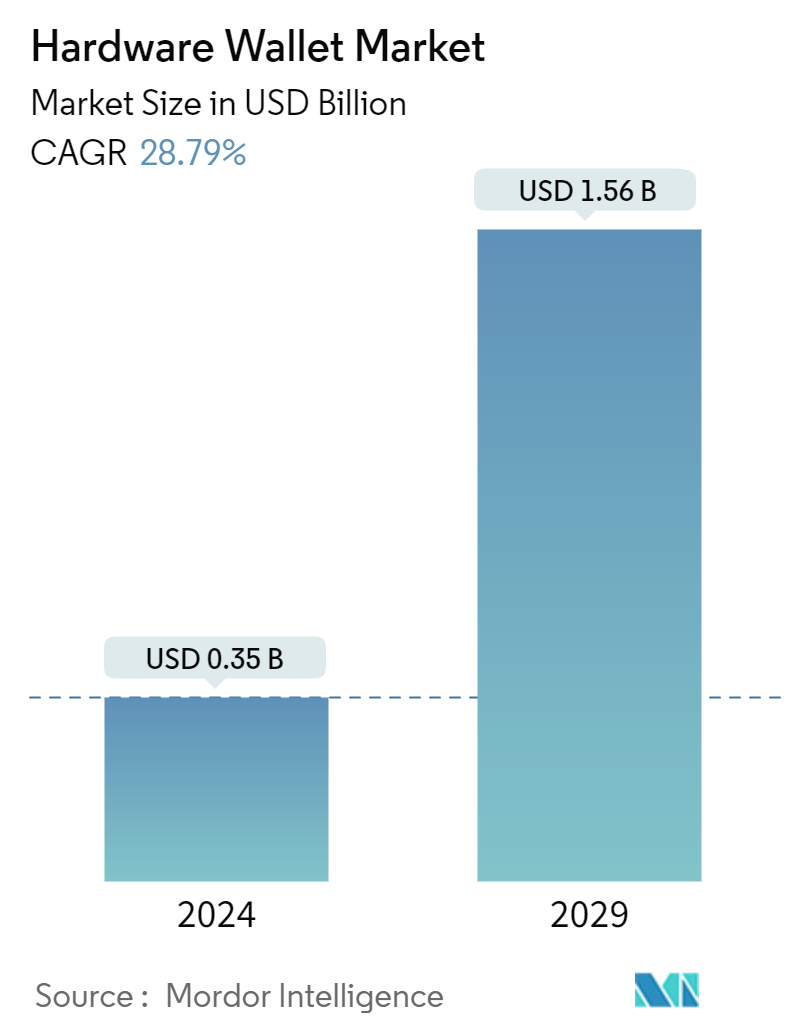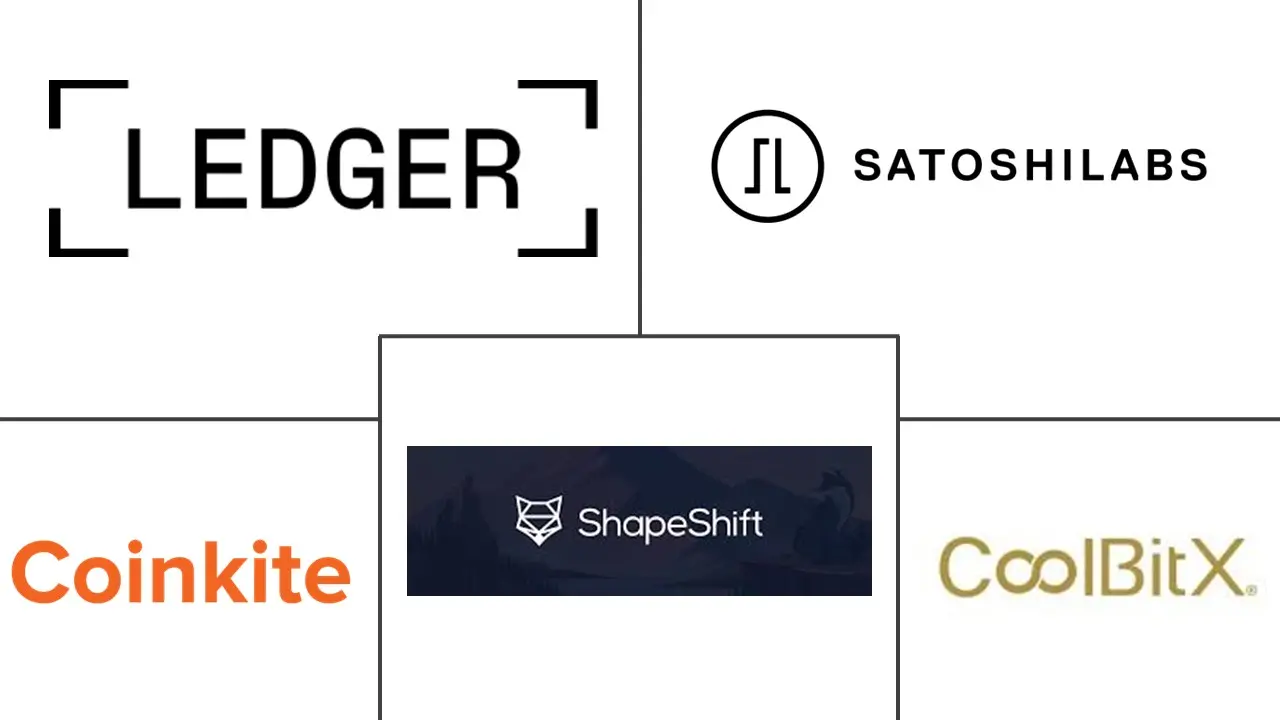Market Size of Hardware Wallet Industry

| Study Period | 2019 - 2029 |
| Market Size (2024) | USD 0.35 Billion |
| Market Size (2029) | USD 1.56 Billion |
| CAGR (2024 - 2029) | 28.79 % |
| Fastest Growing Market | Asia Pacific |
| Largest Market | Europe |
| Market Concentration | Low |
Major Players
*Disclaimer: Major Players sorted in no particular order |
Hardware Wallet Market Analysis
The Hardware Wallet Market size is estimated at USD 0.35 billion in 2024, and is expected to reach USD 1.56 billion by 2029, growing at a CAGR of 28.79% during the forecast period (2024-2029).
Hardware wallets are specially designed cryptocurrency wallets that securely store users' private keys on encrypted hardware. These wallets allow users to safeguard sensitive data by storing private keys in a protected area within a microcontroller.
- The surging interest in cryptocurrency trading is driving the market. These devices are now extensively adopted for business purposes. Moreover, wallet programs incorporate robust anti-theft and anti-hacking features, rendering them less susceptible to potential risks. Moreover, it has been anticipated that the enhanced security offered by these devices, compared to software, paper wallets, and web-based alternatives, will drive market expansion during the forecast period.
- Moreover, continuous advancements in hardware wallet technology led to improved security features, user experience, and compatibility with various cryptocurrencies. These advancements make hardware wallets more appealing to both novice and experienced cryptocurrency investors. Also, the entry of institutional investors into the cryptocurrency market further boosts the demand for secure storage solutions. Institutions typically prioritize security and compliance, making hardware wallets an attractive option for storing large amounts of digital assets.
- Decentralized finance (DeFi) is significantly impacting global industry. These platforms provide financial services like lending, borrowing, and asset management without relying on traditional intermediaries such as banks. DeFi users seek secure transaction management, and hardware wallets have emerged as the safest option. Their physical confirmation requirement adds an extra layer of security. As the DeFi market grows, the demand for secure ways to interact with these platforms will continue to drive the industry globally.
- Governments may impose regulations limiting the sale or use of hardware wallets for storing cryptocurrencies. For example, they might require extensive KYC (Know Your Customer) procedures for purchasing hardware wallets, hindering their accessibility. This pandemic slowed down the adoption of hardware wallets.
- The pandemic's rapidly increasing demand for cryptocurrencies has positively impacted the hardware wallet market. Bitcoin and other cryptocurrencies are gradually moving from unreliable investment vehicles to being accepted as forms of payment. The COVID-19 pandemic has increased calls for the dematerialization of payments, which has raised awareness of payment practices and the financial life cycle.
Hardware Wallet Industry Segmentation
The hardware wallets market is defined by the revenue generated by selling hardware wallets provided by key global vendors.
The Hardware Wallet is segmented by type (USB, NFC, and Bluetooth) and geography (North America, Europe, Asia Pacific, and the Rest of the World). The market sizes and forecasts are provided in terms of value in USD for all the above segments.
| By Type | |
| USB | |
| NFC | |
| Bluetooth |
| By Geography | |
| North America | |
| Europe | |
| Asia-Pacific | |
| Rest of the World |
Hardware Wallet Market Size Summary
The hardware wallet market is experiencing significant growth, driven by the increasing interest in cryptocurrency trading and the need for secure storage solutions. Hardware wallets, which store private keys on encrypted hardware, offer enhanced security compared to software, paper, and web-based alternatives. This market expansion is further fueled by continuous advancements in technology, improving security features, user experience, and compatibility with various cryptocurrencies. The entry of institutional investors into the cryptocurrency market has also boosted demand, as these entities prioritize security and compliance for storing large digital asset volumes. Additionally, the rise of decentralized finance (DeFi) platforms, which require secure transaction management, has positioned hardware wallets as a preferred choice for users seeking robust security measures.
The Asia-Pacific region is a significant growth area for hardware wallets, driven by the rising adoption of cryptocurrency and the trend towards digital and cashless payments in countries like India, China, and South Korea. The market is also benefiting from the integration of blockchain technology, which enhances security and transparency. The increasing incidence of cybercrime and the expansion of e-commerce platforms have heightened the need for secure storage solutions. The market is characterized by a high level of fragmentation, with both global players and small to medium-sized enterprises competing. Major companies are adopting strategies such as partnerships and acquisitions to enhance their offerings and maintain a competitive edge. Overall, the hardware wallet market is poised for substantial growth, supported by the rising interest in cryptocurrencies, cyber threats, and technological advancements.
Hardware Wallet Market Size - Table of Contents
-
1. MARKET INSIGHTS
-
1.1 Market Overview
-
1.2 Industry Value Chain Analysis
-
1.3 Industry Attractiveness Porter's Five Forces Analysis
-
1.3.1 Bargaining Power of Suppliers
-
1.3.2 Bargaining Power of Buyers
-
1.3.3 Threat of New Entrants
-
1.3.4 Threat of Substitute Products
-
1.3.5 Intensity of Competitive Rivalry
-
-
1.4 Assessment of the COVID-19 Impact on the Market
-
1.5 Assessment of Macroeconomic Factors
-
1.6 Case Study Analysis
-
1.7 Regulatory Implications
-
1.8 Hardware Wallet Comparison (comparison of Key Vendors Products)
-
-
2. MARKET SEGMENTATION
-
2.1 By Type
-
2.1.1 USB
-
2.1.2 NFC
-
2.1.3 Bluetooth
-
-
2.2 By Geography
-
2.2.1 North America
-
2.2.2 Europe
-
2.2.3 Asia-Pacific
-
2.2.4 Rest of the World
-
-
Hardware Wallet Market Size FAQs
How big is the Hardware Wallet Market?
The Hardware Wallet Market size is expected to reach USD 0.35 billion in 2024 and grow at a CAGR of 28.79% to reach USD 1.56 billion by 2029.
What is the current Hardware Wallet Market size?
In 2024, the Hardware Wallet Market size is expected to reach USD 0.35 billion.

